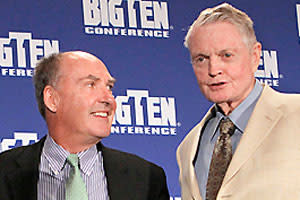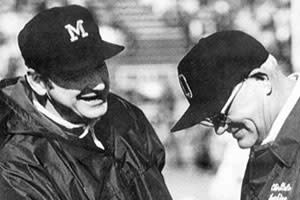Big Ten selling out tradition
Follow Dan Wetzel on Twitter at @DanWetzel
Michigan and Ohio State first played football in 1897. Never once has it taken place outside Columbus or Ann Arbor. Since 1935, it's served as the final game of each team's regular season.
It's not just the culmination of a football campaign, but an unofficial, yet beloved, holiday in the Midwest. It represents a Saturday afternoon in late November, after the crops are in, touched by faint sunlight and a crisp wind that occasionally drives flakes of snow.
It's meaning is everything. To this day the final segment of practice at Ohio State is called the "Maize and Blue Period" complete with the Michigan fight song, "The Victors," blaring over the loudspeakers to infuriate, and motivate, the Buckeyes. Beating Michigan or beating Ohio State is what the teams work toward. It represents seeing the season through, either for their own glory or to ruin their rivals.
Wetzel's Divisions
How Yahoo! Sports columnist Dan Wetzel would split the Big Ten into divisions:
Indiana
Michigan
Michigan State
Northwestern
Ohio State
Purdue
Illinois
Iowa
Minnesota
Nebraska
Penn State
Wisconsin
"They build their seasons up to it," said Michael Rosenberg, Detroit Free Press sports columnist and author of "War As They Knew It," a book about the 10 years of games between Woody Hayes and Bo Schembechler.
Through it all, going on 104 years, it's become one of the greatest rivalries not only in college football, but also in all of American sports. While that's a debatable title, there's no question Michigan-Ohio State would be in the discussion.
It's not just about who wins and who loses or what is won and what is lost. It's a celebration of a culture, a day both look forward to and look back on, a feeling of time and place, of memories and roots that run deep in the Midwest soil. You watched with your grandfather. You'll watch with your grandchildren. No matter when things are good or things are bad – and with both football and the economy, these two states have seen both – it is always there, always the same. To play in it is to play in something bigger than yourself, your team and even your school.
"A remarkable festival," the announcer Keith Jackson described it on its 100th birthday.
It's special. It just is.
And now the Big Ten wants to pretend it isn't?
They are going to move the game to October and they are going to split Michigan and Ohio State up and put them in opposite divisions of the new 12-team Big Ten to allow for the possibility of a league title game rematch starting in 2011.
This hasn't been announced. It's all but certain though, the drumbeat of public relation leaks assuring it. Commissioner Jim Delany has talked about it. So too has Ohio State coach Jim Tressel and Michigan athletic director David Brandon.
They want the idea to float out there so it isn't a shock to the system when it becomes official next month. It may not shock, but it should sadden.
Ohio State and Michigan should be placed in the same division and meet in the final game of the regular season. It works for Auburn-Alabama, Texas-Texas A&M and a host of other great rivalries that have survived the super conference era. It's a nod to the concept that these are more than just games, that they aren't just a product to package for television, that in college football, tradition should be honored, not reworked in the hope of a ratings bump.
"One of the best things that could happen, in my opinion in a given season, would be the opportunity to play Ohio State twice," Brandon told Ann Arbor radio station WTKA.
No, it wouldn't be the best thing that could happen. It might be fun the first time. It might be unique. It might be new. And then soon enough, it wouldn't be.
Everything else about it diminishes an event built and maintained for five generations. When you control a 100-plus-year-old tradition, you don't make decisions based on a four-year television contract. To do so is symbolic of the NCAA run by MBAs, where a projected spreadsheet means more than a history book. It is about selling out a century plus for an overnight rating and then trying to explain it away with specious and short-sited reasoning.
The game is the game because they don't play twice a year. You get one crack and that's it. It can make or break the season. Careers, both playing and coaching, are defined by it because the lack of a rematch raises the stakes. The single game increases the urgency of the present. Then the location on hallowed grounds – either the glorious Horseshoe or the brilliant Big House, not some corporate event at Lucas Oil Stadium – adds the perspective of the past. As such, the nature of the rivalry should be protected at all costs.
Instead, not only does the Big Ten want to split the teams up to assure a potential second game, but it also wants to move the annual clash to midseason in case both teams win their division. Otherwise there might be back-to-back meetings that could cost the title game broadcast casual viewers. This is the butchering of the regular season in an effort to protect the postseason.
There is no other reason to do it. It isn't for competitive reasons, since it actually stacks the deck against Michigan and Ohio State – their cross-over opponent is a historic powerhouse.
The Big Ten title game is undoubtedly worth more if Ohio State and Michigan, two big brands with plenty of big television markets, can potentially meet. Nebraska may teem with history, but it doesn't with people (just 1.7 million residents compared to the 10 million-plus of both Michigan and Ohio).
So what's the mere possibility of a Buckeye-Wolverine Big Ten title clash actually worth? One television executive estimates it at best fetches an additional $2 million on a game that the Big Ten is seeking $15-$20 million no matter who is in it. "And with the state of (the Michigan) program, I doubt it's that," said the TV executive who requested anonymity. "That's absolute the high end, and I haven't done any research. It might be half that."
So best case, the league gets $2 million extra per year, which divided 13 ways (12 teams and the league office) is about $150,000 per share. The Buckeyes and Wolverines are going to sell their one-of-a-kind tradition for a buck fifty per?
That's the going price of history?
The likelihood of a Michigan-Ohio State rematch isn't strong anyway (which the TV execs will realize upon research) and not just because the Wolverines went 1-7 in the league last year. Doug Lesmerises of the Cleveland Plain Dealer reports that had the two teams been split into opposite divisions over the past 17 years, they'd have met just three or four times in a title game. This isn't the old days of the Big Two and Little Eight, and that's before Nebraska makes it more competitive.
Lesmerises notes that only five times since 1988 have both teams been ranked in the top 15 on game day. While the 2006 game between No. 1 Ohio State and No. 2 Michigan springs to mind, the rivalry is mostly about one team trying to ruin the other's big year.
It's also a rivalry of swings. Bo and Woody may have gone back and forth – Michigan holding a 5-4-1 lead in that era – but prior to the Buckeyes winning eight of the last nine games, Michigan won 10 of 13.
That the game maintained – if not increased its appeal – during these runs of dominance is a testament about how its value is in the total package. It's about the people. It's about the stadiums. It's about the circle of the calendar. It's about the often gloomy weather that in its own Midwestern way is beautiful. It's about all the intangibles that make this game and this sport so great, far greater than some financial metric can measure.
Once there is even the potential for more than one game, once it is moved to a midseason date, once it isn't the final test, once it isn't about clearing (or being) the last hurdle to a season, once it is staged in some faux-retro NFL stadium, it becomes a little more like just another game. This is what happened to the once-wonderful Oklahoma-Nebraska rivalry that in just more than a decade went from special to likely extinct, one more bit of history sucked from the sport in the name of a small pot of possible revenue.
"It's always been about the anticipation," Rosenberg said of Michigan-Ohio State. "It was about working to that final game, about what's at stake, winning a championship or screwing it up for the other guy. That's what was always special about it."
So special it came to define the league. Patience created a brand so strong it could command high broadcast fees and launch its own television network and draw in Nebraska and Penn State to the point where a title game is needed.
Now the suits are ready to think short-term and cash in on its appeal. Now it's just another product to squeeze out $150,000 from.


